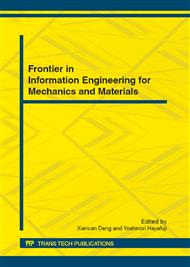p.232
p.239
p.245
p.250
p.255
p.260
p.265
p.270
p.274
Research of Non-Destructive Testing of Wire Rope Using Magnetic Flux Leakage
Abstract:
Based on the magnetic theory, the paper reviewed the factors of affecting the distribution of magnetic flux leakage (MFL) on the ferromagnetic material and analyzed the wire rope defects characters from MFL signal. A non-destructive testing (NDT) instrument of steel wire rope using magnetic flux leakage was presented in this paper. By using permanent magnets to magnetize wire rope and using Hall element arrays to test MFL, Intelligent signal processing was applied for effective discrimination of wire rope’s flaws. The experiment results show the degree and the width of defects, the annular distribution of localized flaws such as concentrated or dispersive broken wires can be well distinguished. The instrument can be used conveniently with good resolution and repeatability and can meet the requirement of real time.
Info:
Periodical:
Pages:
255-259
Citation:
Online since:
July 2012
Authors:
Price:
Сopyright:
© 2012 Trans Tech Publications Ltd. All Rights Reserved
Share:
Citation:


